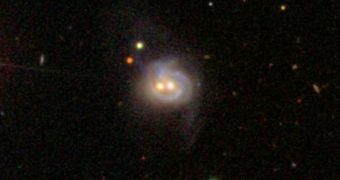A new scientific investigation has revealed the presence of yet another enormous black hole, at the core of a galaxy where experts had already discovered a supermassive black hole during previous studies.
The two cosmic giants apparently share the same home, experts say, inside the galaxy Markarian 739. The cosmic structure is located about 425 million light-years away from Earth, which is relatively near-by in astronomical terms.
Scientists operating the NASA Swift satellite and the NASA Chandra X-Ray Observatory were the ones who managed to identify the second black hole, orbiting close to the known one. The two may be in the process of merging with each other.
However, the objects are some distance away from each other, the new study also showed. Apparently, they are separated by 11,000 light-years, which is the equivalent of 33 percent of the distance separating our entire solar system from the core of our galaxy.
Both black holes have recently been cataloged as supermassive, which means that they can have the mass of billions of Suns. These objects are still extremely active, and thousands of times heavier than black holes produced via stellar collapses.
“At the hearts of most large galaxies, including our own Milky Way, lies a supermassive black hole weighing millions of times the Sun's mass,” explains researcher Michael Koss, the lead author of a new study detailing the findings.
“Some of them radiate billions of times as much energy as the Sun,” adds the expert, who holds joint appointments at the NASA Goddard Space Flight Center (GSFC), in Greenbelt, Maryland, and the University of Maryland in College Park.
He goes on to say that discovering two black holes capable of producing active galactic nuclei (AGN) in the same galaxy is extremely unusual. AGN are extremely rare as it is, and they can mostly be seen in distant galaxies powered by quasi-stellar radio sources (quasars).
Markarian 739 is not the only galaxy to display such twin, supermassive black holes. The galaxy NGC 6240, located approximately 330 million light-years from Earth, also has a similarly-active core, Space reports.

 14 DAY TRIAL //
14 DAY TRIAL //